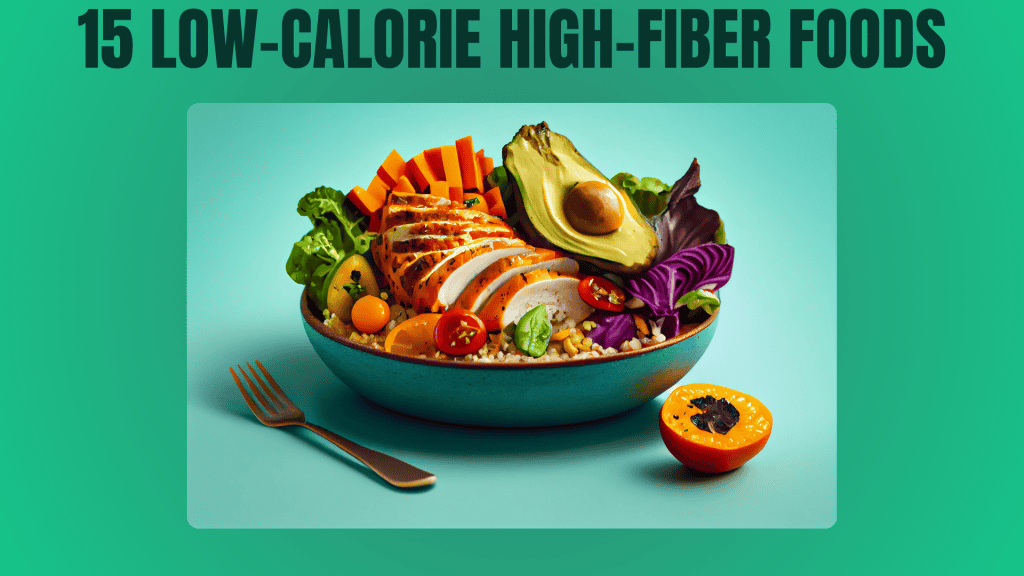One simple and effective way to manage weight loss and improve overall well-being is by adding foods with high fiber and low calorie to your diet, some of these foods being broccoli, oats, and apples, which are relatively low in calories yet full of fiber, helping you feel fuller for longer that is causing one not to overeat and seek those unhealthy snacks. In other words, the goal is to retard digestion, so you stay satisfied longer. They also regulate your blood sugar levels, which helps suppress cravings and smooth your energy fluctuations over the day. For example, lentils and chickpeas are well-known as good plant-based protein sources with fiber content that can help fill you up nicely during meals.
To continue further, foods like chia seeds, avocados, and pears bring the perfect mix of fiber and healthy fats, which are awesome for heart health. Also, fiber-rich vegetables like Brussels sprouts and sweet potatoes are loaded with all the necessary vitamins and minerals yet low in calories. Similarly, munch on air-popped popcorn for that delicious crunch without guilt, as they are rich in fiber but contain virtually no calories. Therefore, high fiber low calorie foods help with weight management and improve digestion significantly. Again, the benefits of fiber go beyond weight management; it also encourages good digestion, reduces cholesterol, and maintains heart health, making these foods a necessary addition to one’s balanced, healthy diet.
How High-Fibre Low-Calorie Foods Help in Weight Loss
In terms of weight loss, fiber is so helpful because, unlike fats or carbs, fiber isn’t fully digested by your body. Rather than being broken down for calories, it passes through your digestive system, adding bulk to your meals without adding extra calories. For example, you can snack on foods high in fiber and low in calories and whole grains, which cannot lead to calorie overloading, keeping you full. Moreover, foods with high fiber and low calories also play a key role in keeping your blood sugar levels steady. For instance, fiber slows down the absorption of sugar into your bloodstream, preventing energy spikes and crashes that often lead to hunger and cravings.
One of the best ways to boost your overall health is eating high fiber low calorie foods daily. Research has also indicated that clients who consume more fiber are more likely to lose weight and maintain it longer than those with less fiber diets. High-fiber foods are also often rich in vitamins and minerals, so you can still feed your body on a reduced-calorie diet. Again, combining fiber-rich and zero calorie foods is the best of two worlds: you feel full, eat less, and yet provide your body with what it needs to thrive.
Benefits of a Low-Calorie High-Fibre Diet
Choosing high fiber low calorie foods over processed options can lead to sustained energy throughout the day. Unlike most nutrients, fiber is not assimilated into the body, so its importance lies in keeping you healthy. Its combination with low-calorie food can control weight and prevent many chronic diseases. Remember the importance of consistency and patience when figuring out how to lose 5 kg in 3 days.
1. Weight Loss
Fibre is one of those nutrients that absorb water while expanding in your stomach, and thus, makes you feel fuller for longer. The more foods with high fiber and low calories you consume, the more you lose weight. This is because fiber absorbs water and expands in your stomach, giving you fullness. As such, you consume fewer calories due to minimal hunger. For example, including vegetables, fruits, and grains in your meals control one’s appetite, meaning one consumes fewer calories throughout the day. In other words, the amount of low-calorie, high-fiber foodstuff consumed automatically engenders a calorie deficit, which is the reason for calling for weight loss.
2. Good Cholesterol Levels
Soluble fiber is a fiber that dissolves in water and helps decrease the absorption of cholesterol. Foods with high fiber and low calories, like oats and beans, are also very good at reducing cholesterol. They contain soluble fiber and will, therefore, be absorbed less by the body. Studies have even shown that an amount as small as 5-10 grams of soluble fiber daily will drop your LDL (“bad”) cholesterol by up to 5%. Moreover, it reduces the risk of heart disease for the benefit of the heart.
3. Better Blood Sugar Control
Fibre slows carbs digestion and absorption, which consequently helps stabilize blood sugars. Further, fiber-rich diets control your blood sugar as fiber slows the rate at which your body digests sugar in your food. Furthermore, it helps to avoid blood sugar spikes, an important work for diabetic patients or even patients who are liable to diabetes. For example, fiber diets maintain your bloodstream sugar throughout the whole day while forbidding your urge for hunger so that you can easily achieve fitness.
4. Low Risk of Caused Heart Disease
Fiber reduces cholesterol levels and suppresses inflammatory processes, hence preventing heart conditions. Foods high in fiber and low calories have been related to a reduced risk of developing heart disease because fiber reduces cholesterol and inflammation, two significant causes of heart illnesses. Studies have shown that those who consume more fiber have fewer chances of heart disease than those who eat less. Additionally, by maintaining an appropriate blood pressure level and reducing cholesterol levels, fiber ensures that one’s heart is healthy.
5. Reduced Risk of Cancer
Fiber helps stir up bowel movement and detoxifies the body to help prevent colon cancer. In addition, high-fiber diets lower the risk of some cancers; however, colon cancer is the most affected. For instance, fibre helps regulate bowel movement, allowing your body to expel harmful toxins easily. Moreover, a high-fiber diet may decrease the risk of other cancers, including breast cancer, because it improves your digestive system and general condition.
6. Increased GI Function
It feeds the good bacteria in your gut, which helps your digestive system. To crown it all, fiber is prebiotic—the one that feeds the good bacteria within your gut and keeps the digestive system healthy. For instance, dietary fibers from sources like whole grains, fruits, and vegetables may regulate the gut microbiome, which is important for digestion and overall health. A healthy gut translates to a healthy immune system and a strict intake of nutrients.
7. Reduced Inflammation
Fibre has been found to decrease inflammation, which is an indicator and precursor of many chronic diseases. A fiber-rich diet is another way of countering the inflammation needed to cause chronic diseases like heart disease, diabetes, and arthritis. Research has proven that a high-fiber diet reduces the body’s level of inflammation. Thus, while including 20 foods for weight loss in your diet improves your digestion, it may also serve as long-term protection against conditions caused by inflammation.
8. Improved Gastrointestinal Health
Fiber regulates bowel movement and prevents constipation, reducing the overall risk of gastrointestinal problems. Additionally, fiber ensures a healthy bowel since it aids in making regular bowel movements and prevents constipation. For instance, a high fiber intake keeps food easily passing through your digestive system. Thus, foods with high fiber and low calorie diet intake assist in enjoying digestion healthily and effectively due to the prevention of problems such as diverticulitis and hemorrhoids.
9. Increased Longevity
A fiber-rich diet has been linked to a longer life: escaping chronic diseases. Once again, a high-fiber diet is associated with a longer, healthier life through interference with most chronic diseases. For instance, fiber reduces the chances of heart disease, diabetes, and some cases of cancer. All can reduce your life. Also, studies discovered that those who eat foods high in fiber and low calories usually live longer than those who use their bodies for less fiber. Therefore, fiber is one ingredient that goes into any health system plan for a long time.
15 Nutrient-Dense Low-Calorie Indian Foods
For better digestion and faster metabolism, adding nutrient-dense, high fiber low calorie foods to daily meals can work magic for overall health and weight management. These also help stay within calorie limits while being excellent sources of fiber, with the added benefit of aiding digestion, regulating blood sugar, and helping keep you fuller for longer periods. Essentially, they provide you with all you need to eat without the extra calories, making them apt for those looking to lose or maintain weight while improving their overall health.
1. Tomato Curries
There’s no Indian household that doesn’t contain tomato-based curries, which are not only yummy but also low-calorie food to make a healthy meal. For instance, tomatoes have lycopene, an antioxidant that benefits one’s heart. Additionally, because lean proteins or vegetables can accompany tomato-based curries, you acquire a nutrient-rich meal that’s also light in calories, making it a win-win for people seeking healthy meals.
2. Egg
Eggs are not high in fiber; however, they are a good source of protein and important nutrients such as vitamin D and B12. If you serve them with vegetables like spinach or peppers, it becomes a very nutritious, low-calorie meal that can be easily prepared and keeps you up for hours. Eggs are versatile and can be prepared boiled, scrambled, or as an omelet.
3. Lentils
These are not only proteins but also supercharged with fiber. For instance, a cup of cooked lentils provides around 16 grams of fiber, making you feel full and healthy for the gut. In addition, lentils may be an easy option for vegetarians to have a nutrient-dense, low-calorie food that’s filling and easy to add to soups, stews, or salads.
4. Oats
Oats are also a good option if you do not want to eat more fast-filling foods with more calories. Simply put, oats contain quite a lot of soluble fiber, which fights cholesterol and keeps you full all day. For instance, oats are the perfect breakfast meal, complemented by fruits and nuts to serve as a healthy, high-fiber meal.
5. Broccoli
Broccoli is a nutrient-dense vegetable rich in fiber, vitamins C and K, and low in calories; therefore, it is the best choice for people keeping track of their weight. It can be added directly to stir-fries or soups or enjoyed as a standalone dish. To give you a sample, one cup of broccoli has about five grams of fiber.
6. Carrots
Carrots are another low-calorie, fiber-rich food item that can easily be added to the diet. They are also a high source of beta-carotene, which is converted into vitamin A and helps support vision and immune function. Carrots can also be a tasty snack, used in salads or steamed with other vegetables for a crunchy, healthy meal.
7. Apples
Apples are an excellent snack option because they are sweet but low-calorie. For instance, one medium apple yields approximately 4 grams of soluble fiber, which may keep you full while regulating your blood sugar levels. In addition, apples are portable, making them convenient for nutrient intake.
8. Cauliflower
Cauliflower is yet another versatile, low-calorie vegetable that is rich in fiber. You can use it as a rice substitute, add it to curries, or even use it as a low-calorie pizza crust. Moreover, it is also rich in vitamins and antioxidants, making it super for people who want to lower their carbohydrate intake without sacrificing nutrition.
9. Berries (Raspberries, Blackberries, Strawberries)
Berries are among the highest-fiber fruits and are low in calories. For example, raspberries contain about 8 grams of fiber per cup. Additionally, berries are packed with antioxidants, which help fight inflammation and support overall health. They’re also a great snack or topping for breakfast or dessert.
10. Cucumber
Cucumber is one of the most refreshing and hydrating snacks ever. It has a high water but a very low-calorie content, so it’s the perfect snack to keep you hydrated without piling on the pounds. Moreover, cucumbers are naturally high in fiber if eaten with their skin attached, making them ideal for digestion and satiety.
11. Red and Yellow Bell Peppers
Bell peppers, especially the red and yellow varieties, are loaded with vitamins A and C but very low in calories. They may add a crunchy punch and lovely color to dishes, and they are simply stunning to look at while being highly nutritious. Furthermore, they contain a good amount of fiber and may be included as a stir-fry, salad, or raw snack.
12. Zucchini
Zucchini is a low-calorie vegetable rich in water and fiber, making it great as an anti-hunger vegetable. It can be spiralized into noodles or added to stir-fries or salads. It’s one easy way to bulk your meals without increasing the calorie count.
13. Lettuce
Lettuce is another low-calorie, fibrous food that makes a perfect salad base. It is rich in vitamins A and K and provides that crunch in a very light and refreshing meal. It also goes well with other nutrient-dense foods such as cucumbers, tomatoes, and lean proteins.
14. Brussels sprouts
Brussels sprouts are so healthy in terms of fiber and well-balanced vitamins and minerals that they can make any meal fantastic. In addition, they help to promote the health of the gut and ease inflammation. For example, roast or steam them for a wonderful savory-sweet flavor and a nutty taste.
15. Pears
Pears are a vastly underrated fruit – extremely good for you and rich in soluble and insoluble fiber. In other words, they help with digestion and keep you fuller for longer. For example, one medium pear has around 6 grams of fiber, so it is a great snack to keep hunger away and the best option for an 800 calorie Indian diet plan.
Less Common Low-Calorie High-Fibre Foods
When you look for foods high in fiber and low calories, you will soon get trapped in the same cycle of using a set of ingredients daily. Still, many lesser-known high fiber low calorie foods help break up the monotony and go on to help manage weight loss by improving digestion. In other words, diversify your meal choices with nutrient-rich new options, keeping your diet interesting to control your calorie intake. Here are some fantastic lesser-known foods that quickly become part of your daily meals.
1. Endive
Endive is one of the great leafy vegetables, rich with very few calories and fiber. For instance, the half of it has only 4 calories and 0.8 grams of fiber. So, it is great to be added to salads or served as an emergency when you need something fast, crunchy, and healthy. Besides that, it contains vitamins A and K, which work well for healthy vision and bones. In a nutshell, adding a little to your diet can change everything.
2. Beet Greens
Beet greens, like celery, are nutrient-rich, silent warriors with less than five calories. One cup boasts a puny 8 calories and 1.4 grams of fiber. It is also iron and calcium-rich, so you build your bones and keep your energy up. Put it in a salad or sauté for a hearty, full-bodied side dish.
3. Broccoli Raab
You can have the broccoli raab if you want some bitter taste. For example, 1 cup contains only 9 calories and has as much as 1.1 grams of fiber; it is suitable for stir-fries or as a side dish. In addition, it is rich in vitamin C, which everyone needs to fit for a long-lasting, strong immune system.
4. Pumpkin Leaves (Cooked)
Only some of you may be familiar with pumpkin leaves; however, they are a beautiful and distinctive addition to soups or stews. In other words, you can boost your fiber while adding almost negligible calories-only 15 calories with 1.9 grams of fiber per cup. Additionally, they are a good source of vitamin A and helpful for your skin and eyes.
5. Chinese Broccoli
Another multipurpose vegetable is Chinese broccoli. For instance, this nutritious food contains as few as 19 calories and 2.2 grams of fiber per cup. Moreover, combined with its traditional Asian cooked form, steaming or sautéing, Chinese broccoli is also a good source of vitamin K and calcium, both very important for healthy bones.
6. Nopales (Cooked)
Nopales, or cactus pads, are one of the most widely used ingredients in Mexican cuisine. With just 22 calories and 3 grams of fiber per cup, they are a great nutritious component to your diet. Additionally, they are rich in antioxidants, which can fight inflammation and even enhance general health.
7. Kimchi
Kimchi is one of those fermented foods that is low in calories and gut health. For example, 1 cup of kimchi provides 23 calories and 2.4 grams of fiber. This food also comprises probiotics that support digestion and enhance your immune system. More than that, the solution of vitamins A and C can provide you with gut health and nutrients.
8. Scallop Squash (Cooked)
This is a very bland squash, but it is super versatile: One cup has only 29 calories and 3.4 grams of fiber. This vegetable roasts beautifully grills well, and lends itself to dozens of tasty dishes to enhance fiber. It is also a good source of potassium, which helps regulate blood pressure.
9. Banana Peppers
If you want to add a little spicy kick to your life, banana peppers are an excellent source to add some fiber to your diet. For example, one cup contains 33 calories and 4.2 grams of fiber. They bring mild heat to a dish and keep the calorie count low while replenishing calories lost by keeping your immune system charged due to their richness in vitamin C.
10. Swiss Chard
Swiss chard is a nutrient-rich leafy green, boasting 35 calories and 3.7 grams of fiber per cup. This makes it fabulous for sautéing or tossing into soups, and it yields a good amount of magnesium—a mineral necessary to keep muscles and nerves working properly. Plus, it is bursting with antioxidants, which help to quell inflammation around the body.
11. Dandelion Greens
Another not-so-popular leafy green is dandelion greens, which taste slightly earthy. An example is 35 calories and 3 grams of fiber per cup. Raw may be taken as an additive to salads or cooked into various dishes. Added is its richness in antioxidants while detoxifying the liver.
12. Kohlrabi
Kohlrabi is fabulous when you like crunch, for example. A full cup has 36 calories and 4.9 grams of fiber, which is amazing in slaws or roasted. And to put the icing on that cake, it is also full of vitamin C, supporting your skin and immune system. One of those vegetables you can enjoy raw or cooked. End
13. Asian Pears
Last but certainly not least are Asian pears, and if you take a few and experience their greatness, one fruit packs 116 calories and 9.9 grams of fiber. You will get the richest fiber you can ingest with vitamin C and potassium, making them perfect for a sweet snack that is good for heart health and digestion.
Tips Before Eating High-Fibre Low-Calorie Foods
Replacing high-calorie snacks with high fiber low calorie foods is a simple strategy to improve your diet. Still, before making such changes, some important tips must be considered to minimize hiccups or unpleasant digestive issues such as bloating. Getting accustomed to it by making slight adjustments and paying attention to your body’s response will help you enjoy the benefits of a high-fiber diet without experiencing any side effects. Below are some important tips to include before consuming foods high in fiber and low calories with the 2000 Calorie Plan.
1. Start Slow
When you transition to high-fiber diets, you should introduce them gradually. This is regardless of your diet, which has little fiber. For example, a sudden increase in fiber intake might lead to bloating, gas, or even cramping because the digestive system needs time to adjust. In other words, gradually introducing fibers will enable your body to adjust to the increased fiber and digest it more efficiently, reducing discomfort.
2. Hydrate
Fiber absorbs water, so hydrating will ensure your digestive system works properly when you eat high-fiber foods. For instance, drinking enough water throughout the day helps to push the fiber through the digestive tract, thus eliminating complications like constipation. Therefore, drink at least 8 glasses of water daily to facilitate things working properly so the fiber works as expected.
3. Balance Your Meals
A diet full of fiber will serve only some of your nutritional purposes. Also, high-fiber foods combined with sources of proteins and healthy fats make for a better balance of nutrients at mealtime. For example, combining lentils, which are very high in fiber, with grilled chicken, a source of lean protein, will make for a filling but nutritionally complete meal. This balance also keeps energy up and supports overall health during the day.
4. Cook Your Vegetables
Some high-fiber vegetables must be cooked for easy digestion. Of course, raw vegetables are full of nutrients. However, sometimes, these nutrients prove more difficult for the stomach to digest. Moreover, slight steaming or cooking also breaks down some of the fiber while retaining all its nutritional content for your benefit.
Have you ever thought about how to lose 5 kg by walking? Here’s how you can make it happen.
Expert Views on High-Fibre, Low-Calorie Foods
Experts have agreed that high fiber low calorie foods are the secret to losing weight and staying healthy. Nutrition Dietitian Dr. Amit Kochar says that a high-fiber diet dramatically improves your health. Its benefits are more inclusive than just helping you lose weight; it strengthens digestion and limits your chances of contracting chronic diseases like diabetes and heart disease. Nutritionist Amit Kochar adds that diversity is the key to a successful high-fiber, low-calorie diet. Add many fibrous foods to your meals to obtain a large spectrum of nutrients while keeping your calorie intake low.
FAQs
1. Can you get enough fiber from food alone?
Yes, you can get enough fiber from a balanced diet rich in fruits, vegetables, whole grains, legumes, and seeds. You don’t necessarily need supplements if you’re eating various high-fiber foods.
2. What foods are low in calories but high in fiber?
Foods like broccoli, cucumbers, zucchini, lettuce, berries, and cauliflower are low in calories and packed with fiber, making them excellent choices for weight loss.
3. How can I increase my fiber without adding calories?
To increase fiber without many additional calories, focus on foods like leafy greens, berries, cucumbers, and zucchini, which are fiber-rich but low in calories. You can also add chia seeds or flaxseeds to your meals, which are fiber-dense.
4. What is the lowest-calorie high-fiber fruit?
Berries such as raspberries and blackberries are among the lowest-calorie fruits while being high in fiber.
5. Are there vegetarian options among these low-calorie Indian foods?
Yes, many of the low-calorie Indian foods like lentils, oats, carrots, tomatoes, and cauliflower are vegetarian-friendly and provide plenty of fiber.
6. How does high fiber help with a low-carb diet?
High-fiber foods can complement a low-carb diet by promoting fullness and improving digestion without spiking blood sugar levels. Fiber doesn’t count toward your net carbs because it isn’t digested in the same way as other carbohydrates.
7. What are the best high-fiber low-carb options?
Some of the best high-fiber, low-carb options include broccoli, cauliflower, spinach, chia seeds, and avocados. These foods are low in net carbs and rich in fiber.









